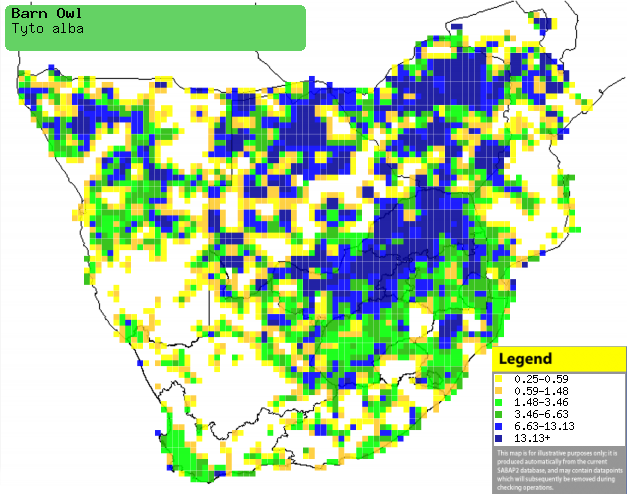|
Tyto alba (Barn owl)
Nonnetjie-uil [Afrikaans]; Isikhova (also applied to
African grass-owl) [Xhosa]; isiKhova (also applied to African grass-owl),
umZwelele [Zulu]; Suunsu (also applied to African grass-owl) [Kwangali];
Sephooko (also applied to Marsh owl and African grass-owl) [South Sotho];
Leribisi [North Sotho]; Zizi (generic name for owl) [Shona]; Xinkhovha [Tsonga];
Lerubise (also applied to African grass-owl and Marsh owl), Morubitshe [Tswana];
alba witte kerkuil [Dutch]; Effraie des clochers [French]; Schleiereule
[German]; Coruja-das-torres [Portuguese]
Life
> Eukaryotes >
Opisthokonta
> Metazoa (animals) >
Bilateria >
Deuterostomia > Chordata >
Craniata > Vertebrata (vertebrates) > Gnathostomata (jawed
vertebrates) > Teleostomi (teleost fish) > Osteichthyes (bony fish) > Class:
Sarcopterygii (lobe-finned
fish) > Stegocephalia (terrestrial
vertebrates) > Tetrapoda
(four-legged vertebrates) > Reptiliomorpha > Amniota >
Reptilia (reptiles) >
Romeriida > Diapsida > Archosauromorpha > Archosauria >
Dinosauria
(dinosaurs) > Saurischia > Theropoda (bipedal predatory dinosaurs) >
Coelurosauria > Maniraptora > Aves
(birds) >
Order: Strigiformes > Family: Tytonidae
The Barn owl has the widest
distribution of any owl and is found in every continent except Antarctica.
It's often associated with deserted buildings, as it uses them as roosting
sites. It preys mainly on small mammals and birds, although termites have
been recorded in its diet. The female incubates the eggs while the male hunts. Incubation starts
with the first egg, which means that there are chicks of different
ages in one nest. Older chicks sometimes feed
their younger siblings and, when food is scarce, sometimes resort to eating
the younger chicks.
Distribution and habitat
It has the most widespread distribution range of
any of the owls in the world and is found on every continent except Antarctica.
It can be found anywhere that has abundant food and suitable roost sites, but
it generally prefers open areas, such as grasslands, deserts and wooded savanna.
Often occurs in areas
occupied by humans, where it normally roosts in buildings, mine shafts and tree
holes. Like most owls it's almost completely nocturnal,
roosting in the day and feeding in the night.
|
 |
|
Distribution of Barn owl in southern Africa,
based on statistical smoothing of the records from first SA Bird Atlas
Project (©
Animal Demography unit, University of
Cape Town; smoothing by Birgit Erni and Francesca Little). Colours range
from dark blue (most common) through to yellow (least common).
See here for the latest distribution
from the SABAP2. |
Predators and parasites
Food
Eats a wide range of prey, which varies in composition according to region. Usually,
its diet consists of 75 - 97% rodents, with the
rest largely made up of shrews and small birds. In urban areas, however, small
birds dominate its diet, making up 40 - 95% of prey items. In desert areas, it
tends to eat a lot of geckos and scorpions. It usually catches its prey by sitting on low branches,
using its powerful hearing to locate small animals. Once it has heard something,
it swoops silently down to the ground, grabbing the prey with its talons. The following animals have been recorded in
its diet:
- Vertebrates
- Invertebrates
Breeding
- It does not build its own nest, but instead most commonly uses
man-made structures (e.g. deserted buildings and mine shafts), tree hollows
and caves. It often uses
the same nesting site over many seasons.
- Egg-laying season is year-round, peaking from August to December in the
Western Cape and from February to May elsewhere in South Africa.
- An average of six eggs are laid per clutch, but can be as high as 19
eggs in boom years, when prey availability is high.
- The female incubates the eggs for 29-34 days, while the male hunts and
brings food to the nest. Incubation starts with the first egg so, since
there is 1-3 day interval between laying, there are always chicks of different
ages in one brood. This means that sometimes older chicks feed the younger
ones but, when food is scarce, the older ones are capable of eating their
siblings.
- The chicks stay in the nest for 45-55 days before fledging. Juveniles
often return to the nest a week after learning to fly, and are able to hunt
about three weeks later.
Threats
Not threatened, in fact common in large areas of southern
Africa. Their population does vary year to year due to the availability of food,
especially rodents.
References
-
Hockey PAR, Dean WRJ and Ryan PG (eds) 2005. Roberts
- Birds of southern Africa, VIIth ed. The Trustees of the John Voelcker
Bird Book Fund, Cape Town.
|
